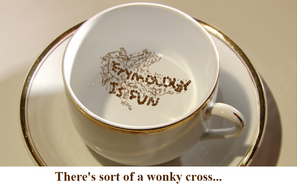|
Harry Potter fans and Times Square 'psychics' alike can tell you that tasseomancy is the art of reading tea leaves. But can they explain the fascinating origins of that word? First, we can break off the Greek suffix -mancy, which literally meant "divination" (so tasseomancy is a narrowing down of that larger field). This is from the earlier word manteia, which meant "oracle", from mantis, "seer", which somehow goes back to the Proto-Indo-European word men, which we've seen before and meant "think". Tasse-, on the other hand, hails from French, where it meant "cup" (thus tasseomancy was "cup divination"; the o belongs to neither, by the way). This is -ooh- from Arabic tas, "cup", eventually from Proto-Indo-Iranian tas, which meant "to make", since one makes cups, supposedly. Curiously enough, there is a little-used and outdated word in English spelled tasse which meant "a piece of armour", though it originally meant "pouch", and though it also shared the meaning of "a kind of container", it has a completely different origin, going through the Germanic languages to Proto-Germanic tasko ("bag") and ultimately the Proto-Indo-European term das, or "to fray". Weird; who could've predicted that?
0 Comments
Your comment will be posted after it is approved.
Leave a Reply. |
AUTHORHello! I'm Adam Aleksic. I have a linguistics degree from Harvard University, where I co-founded the Harvard Undergraduate Linguistics Society and wrote my thesis on Serbo-Croatian language policy. In addition to etymology, I also really enjoy traveling, trivia, philosophy, board games, conlanging, and art history.
Archives
December 2023
TAGS |



